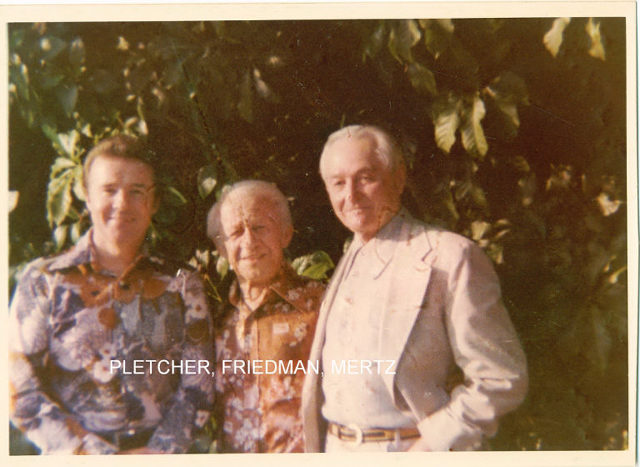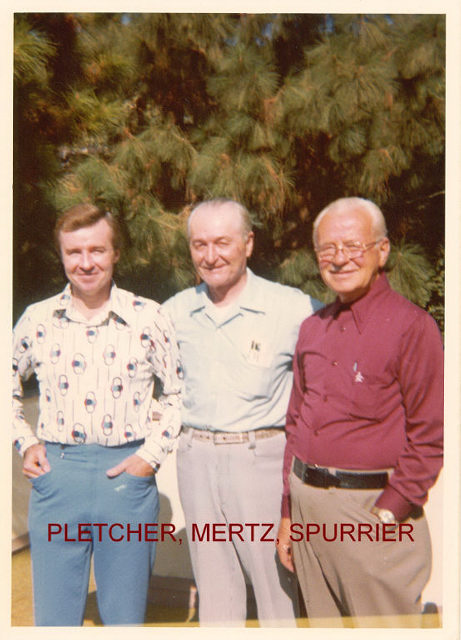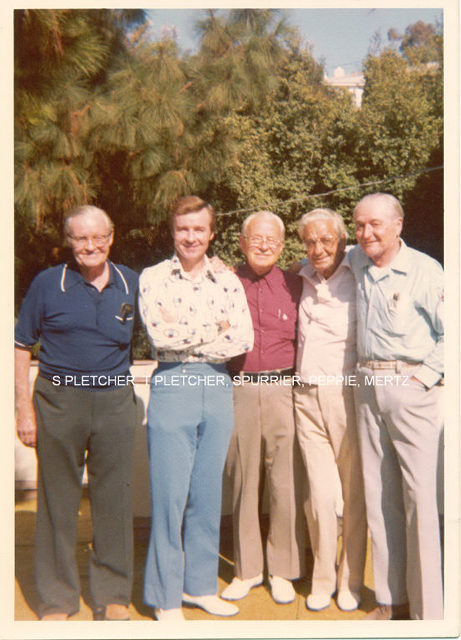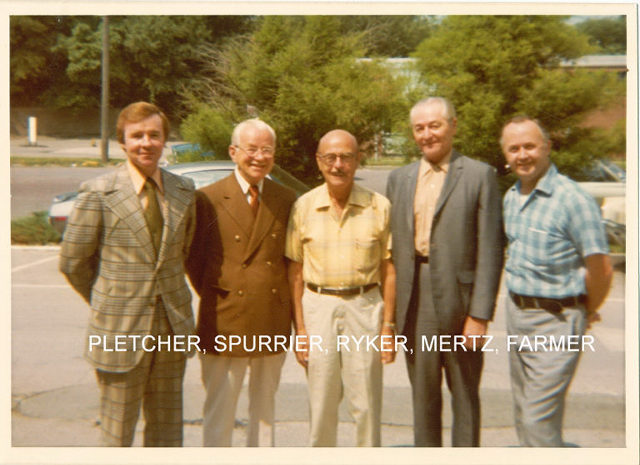A
series of columns about Bix by
guest
contributor Tom Pletcher.
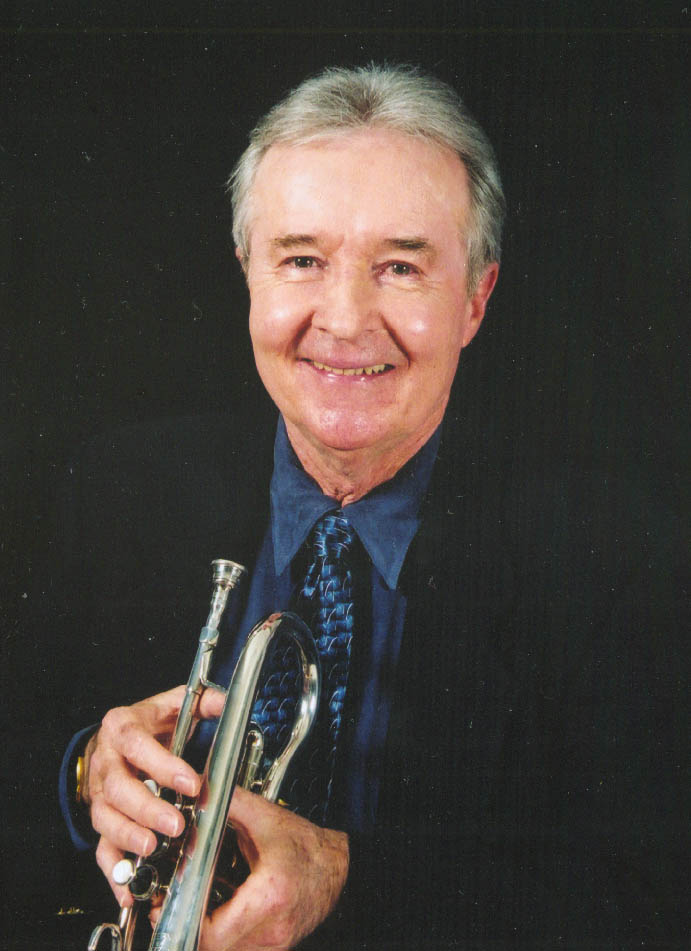
A
series of columns about Bix by
guest
contributor Tom Pletcher.

Jazz music is a heritage for Tom Pletcher. His grandfather, Thomas M. Pletcher, was a leader in the piano roll industry in the 1920s. His company, QRS, employed such jazz luminaries as James P. Johnson, "Fats" Waller, and others of stride style piano.Tom's father was "Stew" Pletcher, trumpet soloist with the orchestras of Tony Pastor, Smith Ballew, Red Norvo/Mildred Bailey, Jack Teagarden, and others. While growing up around jazz musicians, it wasn't until Tom happened upon one of his father's original 78 records -Frank Trumbauer's recording of "Baltimore" and "Humpty Dumpty" featuring Bix Beiderbecke- that Tom decided to take up the cornet to perpetuate the style of Bix.
In the decades since, Tom has performed at festivals, concerts and clubs throughout the United States, Australia, Europe, and England. For 17 years, he was the principal cornetist for the "Sons of Bix" band which originated in Chicago in 1973. He has recorded for Jazzology, Fairmont, RCA, Swaggie, Circle, Wolverine, Taylor, Teaspoon, Stompoff, and Arbors. In 1990, he was chosen to play the soundtrack role of Beiderbecke in the Italian film "Bix, An Interpretation of A Legend" which featured Bob Wilber, Kenny Davern and others.
Tom is a founding member of the Bix Beiderbecke Memorial Society, and appeared at several of the early Bix Jazz Festivals in Davenport, IA, with such notables as Bill Rank, Wingy Manone, Spiegle Willcox, Bill Challis, Chauncey Morehouse, Doc Ryker, and Paul Mertz.
In
November 2003, Tom organized and led the Bix Centennial Band aboard the
Bix 100th Birthday Cruise.
"IN A MYTH." Part I: “Cloudy.”
Thanks entirely to the dedication and sincerity of Albert Haim and his immense web site, I have this opportunity to express my concerns and opinions regarding allegations made by persons claiming inside information about Bix Beiderbecke which do not hold up. In this first instalment, I wish to present my case as it relates to Indiana songwriter/musician Charlie Davis. Bix fans know of Davis after seeing the Berman CBC documentary entitled “Bix. Ain’t None of Them Play Like him Yet”. (Playboy Jazz DVD PBV 9043)
CLOUDY.
In the filmed interview, Davis, while reminiscing about his brief encounters in 1924 with Bix and the Wolverines, remembers the following: “I remember Bix played (piano) a tune I had never heard, before or since, but I recorded it in my own mind. I remember he was a great man to play on the black keys. He was a black key man …”
Sorry Charlie but Bix was anything BUT a black key man. That fact was clearly established while Bix was alive. He played piano in C and F, as other self-taught players prefer or are most familiar. All of Bix’s piano pieces are in concert C. He recorded “For No Reason At All In C” with Trumbauer and Lang. There was a very good reason: Bix’s limitation at the piano.
“Cloudy” a nostalgic piece made up of a simple melody and block chords has no typical Bixian runs or extended or impressionistic chords so associated with Bix. Nor did anyone with whom I knew and consulted ever hear this piece until Davis’s on camera rendition.
That
Charlie Davis should have been nominated for an Academy Award for his
performance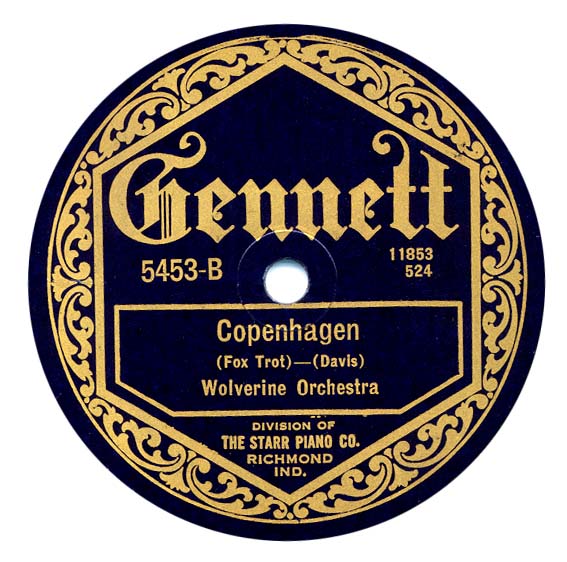 does have merit, in my opinion. During the years 1973-92, I was in
failry
close company with the following men who were associated with Bix
during
his brief life. They were Bill Challis, Paul Mertz, Bill Priestley,
Esten
Spurrier, Bill Rank. Other fellow contemporary Bixians were Edwin
“Squirrel”
Ashcraft, James “Rosy” McHargue, Joe Rushton, with whom I shared the
passion.
Researcher friends have included Philip Evans and Norman Gentieu. Not
one
of the guys who viewed and heard Davis perform, thought “Cloudy” was
Bix’s
composition nor did anyone hear Bix play a piece resembling Davis’s
rendition
for the documentary. That Charlie wanted to be remembered as a Bix
sympathizer
is obvious and the film gave him his last moment in the sun and
opportunity
for immortality along with Bix. Sorry again Charlie.
does have merit, in my opinion. During the years 1973-92, I was in
failry
close company with the following men who were associated with Bix
during
his brief life. They were Bill Challis, Paul Mertz, Bill Priestley,
Esten
Spurrier, Bill Rank. Other fellow contemporary Bixians were Edwin
“Squirrel”
Ashcraft, James “Rosy” McHargue, Joe Rushton, with whom I shared the
passion.
Researcher friends have included Philip Evans and Norman Gentieu. Not
one
of the guys who viewed and heard Davis perform, thought “Cloudy” was
Bix’s
composition nor did anyone hear Bix play a piece resembling Davis’s
rendition
for the documentary. That Charlie wanted to be remembered as a Bix
sympathizer
is obvious and the film gave him his last moment in the sun and
opportunity
for immortality along with Bix. Sorry again Charlie.
Regarding Davis’s claim about Bix having several tones and that “the girls liked his dirty tone”, give me a break! Listen to anything Bix recorded and tell me when you hear anything except that clear sound that only Bix got, even when he had to play into a mute. Incidentally, the above film rendition of “Cloudy” is played in concert Db, a key which Bix and most other self taught and limited pianists would stay away from at all costs.
My concerns are that Charlie Davis’s claims have already been accepted as fact and recorded by sincere and wonderful musicians as a further tribute to dear Bix.
The late biographer/author Philip Evans devoted many early years of his fact-finding research into disproving and dispelling the many absurd rumors that had surfaced since Bix’s death. Now, I feel a duty and a need to speak out on suspect matters of conjecture and claims related to the legend of Bix.
My
next instalment of “In A Myth” will deal with Joe Venuti’s 50-year
secret
recollection of his collaboration with Bix on their so-called
composition
“Betcha I Getcha.”
Uploaded July 5, 2004
Tom
Pletcher welcomes
replies from interested persons; however, he requests conventional
mail.
For Tom's address, please write to ahaim@bixography.com.
Alternatively,
postings in the Bixography Forum are acceptable. These will be relayed
to Tom.
“IN A MYTH.” Part II: “Betcha I Getcha.”
What might
become a futile campaign
to disprove various claims and allegations having to do with hitherto
undiscovered BIX compositions, I wish now to discuss the Joe Venuti
story about collaborating with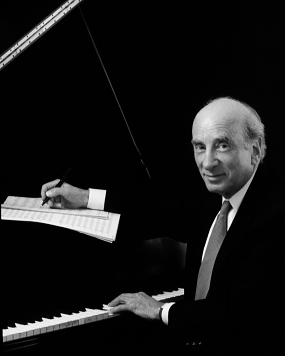 Beiderbecke on a tune called "Betcha I
Getcha". This revelation surfaced 30 years ago during a Venuti
recording session (1973) during which time he played a piece on piano
for Dick Hyman claiming that he and Bix worked it
out together etc.
Evidentiy, Hyman, believing Venuti to be telling the truth, got
Venuti’s piano rendition on tape and transcribed and published the
piece many years later in one of his own music books.
Beiderbecke on a tune called "Betcha I
Getcha". This revelation surfaced 30 years ago during a Venuti
recording session (1973) during which time he played a piece on piano
for Dick Hyman claiming that he and Bix worked it
out together etc.
Evidentiy, Hyman, believing Venuti to be telling the truth, got
Venuti’s piano rendition on tape and transcribed and published the
piece many years later in one of his own music books.
I know Dick Hyman to be a very intelligent, honest, sincere and dedicated man and Bixophile who has lovingly showcased Bix’s music in many ways, the latest being his Arbors CD "If Bix played Gershwin" which Dick and I and his studio band recorded together only last year. Hyman clearly speculated on the validity of Venuti’s sudden claim, but it has since gained dangerous stature. Having grown up around many of the jazz greats of the 20s and 30s, of course I have heard many Venuti stories particularly about his wit, practical jokes, musical skills as well as his widely known reputation for stretching the truth especially if it might further his self image, ego and career. Without attempting to sugar coat his name, he was notorious for lying about his date of birth, place of birth and other matters about which he had personal knowledge. Additionally he was considered a very crude and vulgar man according to more sensitive persons such as other musicians wives who were not charmed by Venuti’s course persona. That he was "one of the boys" within the jazz circles is without question. That he was also the greatest hot violinist of the 20th century also wins my vote. <>I have absolutely no doubts or suspicions of the intentions of these friends and great musicians in their presentations of what they want to believe are Bix discoveries. However, having studied the subject of Bix and his music for 50 years as well as having known many of Bix’s closest musical associates, I feel entitled and compelled to question the authenticity of these latter day claims.
Unfortunately,
Joe Venuti’s
unfounded image as a real friend of Bix was vastly inflated by a role
played in the 1990 Italian film "Bix" in which Venuti, among
other
highlights, drives to Davenport for a personal visit and brings flowers
to Agatha, Bix’s mother. Now that IS funny! Of course being an Italian
made film, Venuti had to be shown in the most favorable light
regardless of the actual truth. Additionally, this well meaning movie
was subtitled "an interpretation of a legend" which allowed for the
liberties taken with
the
Dick Hyman
story. Again, I was honored to participate in
the sound track of this film which received high praise by other
musicians and knowledgeable
critics.
Giuseppe "Joe"
Venuti was born in
Philadelphia, not in Italy or on a ship bound for America as he
claimed. The year of his birth was 1903, not 1899 or earlier. Before he
died in 1978 at the age of 74, he was giving his age as 82
or 84
whatever he thought would make the boldest impression.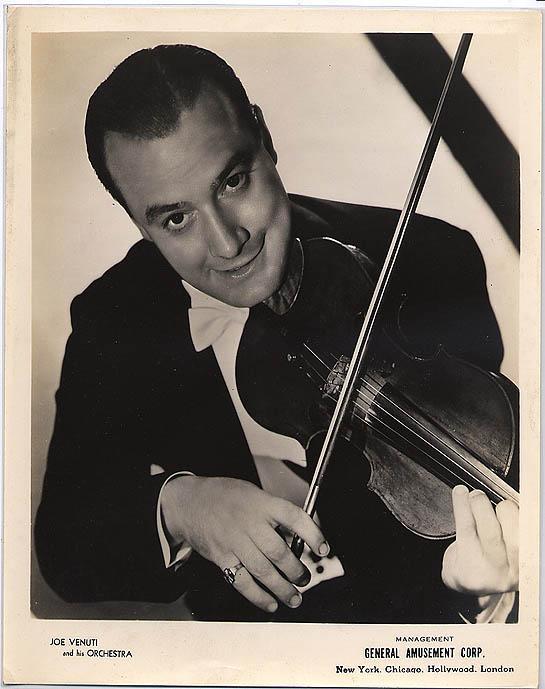
Betcha I Getcha should never have been credited to Leon Bix Beiderbecke, especially on the word of Joe Venuti. Having now heard the 1945 version of this number featuring Kay Starr’s vocal, it is reminiscent of Ralph Flanagan’s popular hit "Hot Toddy" which I think was of similar vintage. Those who still wish to consider this tune as a lost musical treasure of Bix's are welcome to place it next to Charlie Davis’s "Cloudy" but they totally lack credibility. If anyone has more factual information on these pieces, please let me know about it.
My expressed complaints as they relate to "discoveries" like these are not a matter of faulty research by believers but a simple matter of no research or scholarship at all!
Bix’s life, legend and documented works are worthy of respect and proper preservation now and forever after. Having recently had the occasion of celebrating the 100th anniversary of his birth, this is no time to see inventions credited to him when there is no proof, only disproof.
In part
III of "In a Myth," I
will write about what some of the better jazz musicians thought about
Bix’s selling out by joining Paul Whiteman in 1927. That being a
captive of that band was not unlike a good paying "day gig" for Bix
with insufficient inspiration or opportunities to play the kind of
music be loved and then with only a token number of fellow jazz players
on the band.
Uploaded September 14, 2004.
 resented and
scorned him over his
poor
musicianship skills, undependability and special attention. Try to imagine what it must have been like
for Bix during rehearsals, recordings and performances when he failed
to play
certain written parts correctly or was too hung over to play well. To the non-drinkers on the band, Bix was
probably no joy to be around. So why
did he join PW instead of going with another jazz group after Goldkette
and
Rollini’s New Yorkers? My theory is
this: Bill Challis and Frank Trumbauer
were security blankets. So was Bill Rank.
They appreciated him and covered for his shortcomings. Contrary to what we hear about Bix being able
to read, he never was able to sight read well or even know how to
properly mark
his parts. Bill Challis told me these
things. Also that he would write Bix
“footballs” just to give him something to do and to keep his horn warm. A football is a slang term for a whole
note. Can you imagine how humiliating
this must have been?
resented and
scorned him over his
poor
musicianship skills, undependability and special attention. Try to imagine what it must have been like
for Bix during rehearsals, recordings and performances when he failed
to play
certain written parts correctly or was too hung over to play well. To the non-drinkers on the band, Bix was
probably no joy to be around. So why
did he join PW instead of going with another jazz group after Goldkette
and
Rollini’s New Yorkers? My theory is
this: Bill Challis and Frank Trumbauer
were security blankets. So was Bill Rank.
They appreciated him and covered for his shortcomings. Contrary to what we hear about Bix being able
to read, he never was able to sight read well or even know how to
properly mark
his parts. Bill Challis told me these
things. Also that he would write Bix
“footballs” just to give him something to do and to keep his horn warm. A football is a slang term for a whole
note. Can you imagine how humiliating
this must have been? Notice
in the long lost 1928 Fox Movietone film what part Bix
played on “My Ohio Home”. He stands to
play about 4 repeat notes throughout a 16 bar bridge and even sits down
before
the end of the last measure. Bix was
obviously never very interested in reading music. The
stories by his sister about his early teachers telling the
family they couldn’t teach the boy anything because he played his
lessons back
to them, with improvements. The St.
Louis symphony trumpet player who is reported to have told Bix he felt
like a
canary in a cage in comparison to Bix’s “God given” gift.
All these stories are part of the legend;
however what has been ignored is Bix’s lack of discipline, ambition and
responsibility to learn to read and write as all the other
professionals
did. This proved to be Bix’s down fall
and early demise.
Though a self taught amateur, I personally
can relate to what it must have been like for Bix to
be in situations where his ignorance
would be exposed. I never
bothered to learn to read music and to this day am always the only
illiterate
on a reading band. I’ve been able to
memorize parts because arrangers and leaders have given me advance time
to
“woodshed”. Bix took parts to Challis
for help before having to perform. Bill
said he never let him down. That is,
unless Bix was having bad days which we know he had with increasing
frequency
after 1928.
Furthermore,
Bix would have avoided taking chances of
humiliation and embarrassment by exposing his weaknesses with a less
tolerant reading
band like Pollack, Goodman, Roger Wolfe Kahn, Casa Loma, and others
where he
probably wouldn’t get such special treatment. Consider that Red Nichols
and
Bunny Berigan both played for PW briefly but merely as stepping stones
to
enhancing their resumes and experience.
Red and Bunny had all the necessary tools to move on to better
jazz
employment. Bix did not.
Then
consider all the tunes recorded by PW 1928-29 which
included Bix. How do you suppose he
felt sitting through such trite material as “Parade of the Wooden
Soldiers”,
“La Paloma”, “Oh Ya Ya”, “Dolly Dimples”, “Chloe”.
And then there were the concert performances.... Wilbur Hall
playing a bicycle tire pump... endless renditions of “Rhapsody in Blue”
until
everyone was turning blue with boredom.
Even some of Challis's arrangements featuring Bix were corny
compared to
the same tunes played by real jazz orchestras.
Hear Whiteman’s “Sugar”. Poor
Bix had to try to make something out of the march tempo so typical of
the
Whiteman style. Sorry, but I believe
Bix was wasted sitting in that band.
Whiteman’s generosity, the fringe benefits, record dates,
continued
association with Trumbauer was all well and good but drove Bix to seek
more
after hour places where he could play his kind of music but also drink
more and
later each night and then have to be up for the next day of travel or
record
date. Bix’s happiest days had to be
when he was on the Goldkette band. Besides
having a swinging rhythm section for solos, he was allowed to find his
own harmonic
3rd parts in the brass section and ride over the ensemble out choruses
as he
wished. Even then, what a tragedy that
this wonderful band was forced to record mostly trite commercial crap. Again, if you scrutinize the library of
Goldkette’s recorded works, much of it is pretty bad and was considered
as such
when it came out. *
It
is regrettable to me that bands today are recreating the
same vastly dated material which was an embarrassment to the musicians
who were
on the original records. How about
those insipid and enforced vocals such as “Idolizing” and “I’d Rather
Be the
Girl in Your Arms”? Insiders
jokingly
referred to alternate lyrics to the 1926 male vocalist Frank
Bessinger’s
version as “I’d rather be the boy in your pants, than the girl in your
arms”.
Jazz
groups, especially white ones were stifled by the
so-called authorities (A & R) record company executives who
directed what
material was recorded with little regard for good taste or what had
made the jazz
bands and soloists popular with listeners.
The Goldkette band was only one of many who had few of their
best
numbers recorded. My father was trumpet
soloist on Red Norvo’s 1936-7 Orchestra.
The brilliant Eddie Sauter was principal arranger but Pletcher
contributed more than a dozen of his own arrangements which were good
enough to
be played on coast to coast radio shows!
This band was, in the 1930s, what Goldkette was in the 20s. They were a sensation according to the best
jazz musicians both black and white.
Yet, only a few of their better numbers got recorded. *
At
least the black bands did not suffer the same fate, as
their recordings were directed to the jazz minded mostly black
listeners and
record buyers who rejected the commercial corn marketed to the white
general
public.
In
summary, Bix managed to provide us with more than enough
great recorded examples of himself showcasing the passion and hotness
of his
horn in spite of the conditions under which he and others were
subjected,
especially when with PW.
In
Part IV of In A
Myth, I will write about the subject of who plays what on the
recordings that
included both Bix and Andy Secrest...and other recordings erroneously
identified as Bix.
*For
further examples of enforced trite
material, please refer to
any alphabetical list of recorded tunes by these otherwise wonderful
jazz
orchestras. Then compare to the tunes
the bands preferred to play.
Uploaded October 12, 2004.
Tom Pletcher welcomes replies from interested persons; however, he requests conventional mail. For Tom's address, please write to ahaim@bixography.com. Alternatively, postings in the Bixography Forum are acceptable. These will be relayed to Tom.
“IN A MYTH.” Part IV: Who's Who.” best sound
quality. He said, "I believe they're called ears." That's the best
response I can give for my evidence on knowing Bix from all the rest of
us who have attempted to sound like him at different times and places.
Perhaps because my 68 year-old ears have been listening so long, I feel
very qualified to write about the subject.
best sound
quality. He said, "I believe they're called ears." That's the best
response I can give for my evidence on knowing Bix from all the rest of
us who have attempted to sound like him at different times and places.
Perhaps because my 68 year-old ears have been listening so long, I feel
very qualified to write about the subject.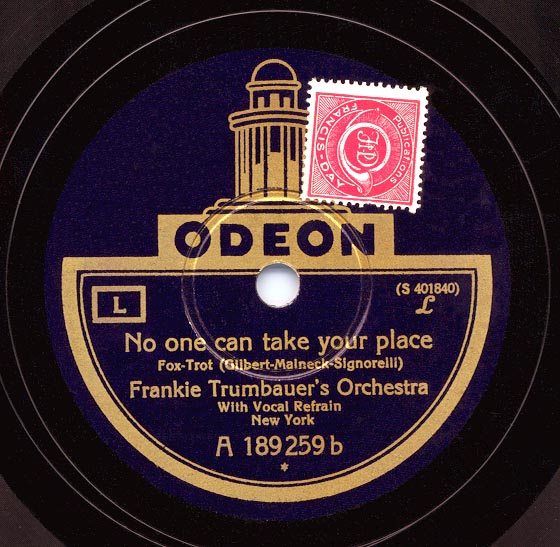 Smith was
regarded by some in the business as Bing's equal in those days and had
some
distinct advantages over Crosby with matinee idol good looks and a
towering
physique. After the string intro, it sounds like Bix timidly reading
the lead
part. Andy plays the counter phrase at :17 and again at :29. After Bill
Rank's
lovely bridge, both Bix and Andy play 2 horn harmony. Bix and Andy
harmonize at
1:07 with the second horn (Andy?) in the low register. Bix comes in at
2:39
(bridge) blowing his soul into either the metal derby or more likely a
felt
hat, which was easy to pack and produced a soft sound as heard here.
Bix
finished his solo by ripping up to a high A and the lead out with no
audible
Secrest. Bix's use of a 6th in the last 2 bars @ 3:05 is totally
evocative of
the classical impressionists such as Frederick Delius or Maurice Ravel.
Smith was
regarded by some in the business as Bing's equal in those days and had
some
distinct advantages over Crosby with matinee idol good looks and a
towering
physique. After the string intro, it sounds like Bix timidly reading
the lead
part. Andy plays the counter phrase at :17 and again at :29. After Bill
Rank's
lovely bridge, both Bix and Andy play 2 horn harmony. Bix and Andy
harmonize at
1:07 with the second horn (Andy?) in the low register. Bix comes in at
2:39
(bridge) blowing his soul into either the metal derby or more likely a
felt
hat, which was easy to pack and produced a soft sound as heard here.
Bix
finished his solo by ripping up to a high A and the lead out with no
audible
Secrest. Bix's use of a 6th in the last 2 bars @ 3:05 is totally
evocative of
the classical impressionists such as Frederick Delius or Maurice Ravel. In
preparing my topics for Part V and reviewing just a fraction of what
has
already been discussed through Prof. Haim's Bix website, I realize my
next
topics are not going to be revelations but more of my own experiences
of
chasing after Bix during the last 50 years.
After
all the frequent visits I made to Davenport during the 1970s, I cannot
recollect this mentioned by anyone I knew. Additionally, I still have a
large
box of personal letters from Phil Evans dating back years before,
during and
after his books were published. I have spent over a hundred personal
hours with
Esten Spurrier who told me so many hitherto unpublished anecdotes and
little
delights about the life and times of Leon. While I remember many
conversations
I had with Spurrier, especially on matters I asked about, never did he
bring up
the unopened records. Spurrier told me that he and Burnie had been
fairly close
friends at some time during their many years as fellow Davenporters.
Spurrier
was employed by a more prominent cemetery than Oakdale where Bix is
buried and
brother Burnie was "caretaker". I sensed that Spurrier was resentful
of the Beiderbecke's rejection of Bix's jazz friends, like him, but it
was
understandable considering that they thought the jazz world was
responsible for
their boy's tragic death.
My
hunch about the records is this. I can believe that Bix sent a few
records
home. Also, that after 1929, when he was borrowing money from his
parents, he
hoped his meager 1930 output with Carmichael and others would impress
them as
he had little else going after Whiteman. That he sent ALL, MOST, or
MANY home
is more than a stretch of credibility.
Bix
was a lazy guy. He was not disciplined about anything including the
condition
of his person, his horn or his professional development. The unopened
records
story has obviously exceeded mythical proportions.
While browsing a marvelous Bix bibliography compiled by a good friend of mine, I came across a September 1936 issue of DOWN BEAT magazine in which an article appeared by the highly regarded Marshall Stearns on the subject of "Swing". He writes the following: "Recently, in going over Bix's private records, left untouched in his house at Davenport, I found practically the whole output of this band (NORK) for the records waxed by this group sold well, and spread its popularity all over the country, some of them selling as many as two hundred thousand copies".
We can each speculate on this 1936 claim by Stearns and whether Bismark and Agatha ever invited him to go through their son's stuff whatever it was. Might this have begun the myth? Concerto in F, even the haunting second movement
featuring the
beautiful trumpet solo work. Having just browsed some of the discussion
forum
comments and there are widely diverse opinions, I will rely on my own
ears as
AURAL evidence.
Concerto in F, even the haunting second movement
featuring the
beautiful trumpet solo work. Having just browsed some of the discussion
forum
comments and there are widely diverse opinions, I will rely on my own
ears as
AURAL evidence.
Playing
an LP of the piece and using my primitive steam powered
turntable, I
hear this:
The first and third trumpet passages are clearly Margulis. The second
or middle
part (Harmon muted) sounds like Goldfield trying to sound like Busse.
Regarding
the intonation problem, please be advised that a Harmon mute renders
any
trumpet or cornet out of tune (sharp). The instrument must be retuned,
sometimes drastically in order to come down to A440 pitch. What makes
me
believe this middle was played by Goldfield?
BLUES
I have seen a sampling of what has already been discussed by contributors, a few of whom I actually know. I agree with a lot of what has been presented. For most of my life, I have gotten to mix with some of the best white and black musicians of the past century. To me and other jazz players, the typical 12-bar blues format is rather boring. It's entry level music. Rock and Roll and that genre has its roots in the standard blues.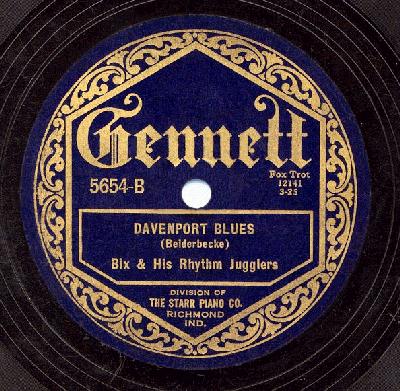 recordings (race records) were trendy in the early
20s and captured the interest and attention of a segment of the white
general public. A barrage of material was composed and recorded under
the guise of blues to capitalize on the craze and is still reflected
in non blues music and performing groups today. Tunes with blues
in the title are not necessarily blues at all!
recordings (race records) were trendy in the early
20s and captured the interest and attention of a segment of the white
general public. A barrage of material was composed and recorded under
the guise of blues to capitalize on the craze and is still reflected
in non blues music and performing groups today. Tunes with blues
in the title are not necessarily blues at all!
SWING
The term swing is another misnomer. Bestowed on jazz during the depression by some music critic/writers as an ADJECTIVE, as though this was a new style of jazz, swing had previously been properly used in VERB form by aware jazz people to describe when the music was very rhythmic or hot. Then, the non-musician authorities declared a whole new breakthrough in jazz. Swing! Swing music, swing dancers, King of Swing, Mr. & Mrs. Swing. Jazz musicians who either swung or not, went along with the new trendy name and continued either swinging or trying to swing. Pletcher's analogy: If a pre "swing" band stunk, then the band must be a stink band, the dancers stink dancers, the musicians, stink musicians. See the absurdity? The blues have suffered nearly the same confusion and meaningless identity.
PAPER
BAG
Here's
another myth like the unopened records that needs closure. Did Bix
EVER carry his horn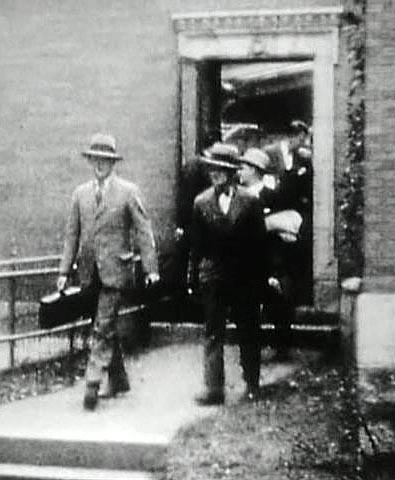 in
a paper bag? Most likely he had
occasion to conceal
his horn in something when his case was elsewhere. Was a paper bag
EVER his preferred method? Of course not. In his last years, (1930-31)
he had a corduroy and cloth sack made for his Bach cornet which
was easy to carry under his arm and less noticeable when walking into
places where he was NOT a hired musician. Perhaps this "bag" might be
where the paper bag story got its origin. Bix's black corduroy horn bag
is still with his personal effects at Putnam Museum in Davenport, Iowa.
in
a paper bag? Most likely he had
occasion to conceal
his horn in something when his case was elsewhere. Was a paper bag
EVER his preferred method? Of course not. In his last years, (1930-31)
he had a corduroy and cloth sack made for his Bach cornet which
was easy to carry under his arm and less noticeable when walking into
places where he was NOT a hired musician. Perhaps this "bag" might be
where the paper bag story got its origin. Bix's black corduroy horn bag
is still with his personal effects at Putnam Museum in Davenport, Iowa.
Evidence of Bix with his horn in a standard hard case can be seen in any of several still photos c. 1924 as well as the later Horvath home movie excerpt where Bix is seen walking with his Conn Victor in a cornet case. Manufactured "gig" bags, which I have always favored, did not become available until decades later. To perpetuate the myth that Bix carried his horn around in a paper bag belongs with the others. Bix and Don Murray, 1926, Bronx Zoo
RALPH
BERTON
 rumored to
be forthcoming. I remember telling Berton that I was a friend and correspondent
of biographer Philip Evans and could not imagine anyone else
expecting to top his definitive work. Ralph reiterated that his book
was to be a memoir of this times with Bix in 1924 and his brother Vic's
prowess as a jazz drummer/inventor/personality.
rumored to
be forthcoming. I remember telling Berton that I was a friend and correspondent
of biographer Philip Evans and could not imagine anyone else
expecting to top his definitive work. Ralph reiterated that his book
was to be a memoir of this times with Bix in 1924 and his brother Vic's
prowess as a jazz drummer/inventor/personality.
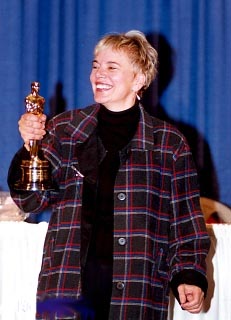 advice with a Bix project was the Canadian film producer Brigitte
Berman. In 1979, I befriended her and an "escort" named Jerry Jest
with lots of material including names, numbers and addresses from my
personal directory of many of the principals she later filmed, interviewed
and consulted for her production. Berman violated nearly everyone's
trust according to the reports that came back to me for years after
the film was released in 1981. She failed to honor promises to return
rare photos and other memorabilia to persons who put their trust in
her and then she disappeared from further contact with everyone including
those who appeared or contributed to her successful documentary.
advice with a Bix project was the Canadian film producer Brigitte
Berman. In 1979, I befriended her and an "escort" named Jerry Jest
with lots of material including names, numbers and addresses from my
personal directory of many of the principals she later filmed, interviewed
and consulted for her production. Berman violated nearly everyone's
trust according to the reports that came back to me for years after
the film was released in 1981. She failed to honor promises to return
rare photos and other memorabilia to persons who put their trust in
her and then she disappeared from further contact with everyone including
those who appeared or contributed to her successful documentary.BIX'S MUSIC
Unlike jazz artists recording in modern times, Bix and many other soloists of his era were told what to play by the dreaded record company executives we've heard about. These tastelessCONCLUSION
My final take on all this is to wonder why the music of the Impressionists who had so much to do with Bix's own concepts of playing jazz
are not being appreciated when so much has been recorded and is available.
The work of Ravel, Debussy, Delius and others are such a delightful
window to seeing where Bix came from, I hope more of you eBixers
will take time to listen and enjoy any of this music. It has soothing
and healing qualities in this age of noise.
do with Bix's own concepts of playing jazz
are not being appreciated when so much has been recorded and is available.
The work of Ravel, Debussy, Delius and others are such a delightful
window to seeing where Bix came from, I hope more of you eBixers
will take time to listen and enjoy any of this music. It has soothing
and healing qualities in this age of noise.
Thanks
to those of you who bothered to render any comments on this series.
